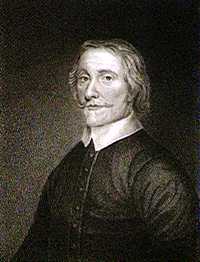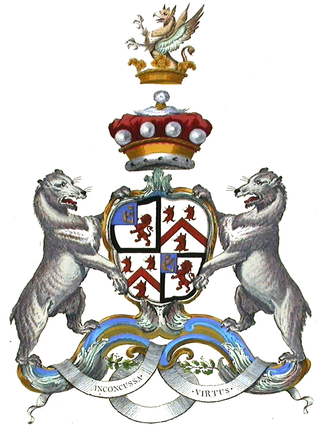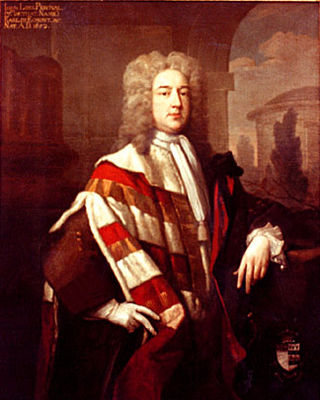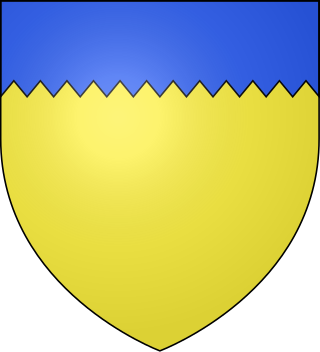Related Research Articles

Duke of Atholl, named for Atholl in Scotland, is a title in the Peerage of Scotland held by the head of Clan Murray. It was created by Queen Anne in 1703 for John Murray, 2nd Marquess of Atholl, with a special remainder to the heir male of his father, the 1st Marquess.

Marquess Townshend is a title in the Peerage of Great Britain held by the Townshend family of Raynham Hall in Norfolk. The title was created in 1787 for George Townshend, 4th Viscount Townshend.

Earl of Halifax is a title that has been created four times in British history—once in the Peerage of England, twice in the Peerage of Great Britain, and once in the Peerage of the United Kingdom. The name of the peerage refers to Halifax, West Yorkshire.

Earl of Romney is a title that has been created twice.

Earl of Verulam is a title in the Peerage of the United Kingdom. It was created in 1815 for James Grimston, 4th Viscount Grimston. He was made Viscount Grimston at the same time. Verulam had previously represented St Albans in the House of Commons. In 1808 he had also succeeded his maternal cousin as tenth Lord Forrester. He was succeeded by his son, the second Earl.

Viscount Valentia is a title in the Peerage of Ireland. It has been created twice. The first creation came in 1621 for Henry Power. A year later, his kinsman Sir Francis Annesley, 1st Baronet, was given a "reversionary grant" of the viscountcy, which stated that on Power's death Annesley would be created Viscount Valentia. Annesley, a member of an influential Anglo-Irish family which descended from Newport Pagnell in the County of Buckinghamshire, was a favourite of James I, who granted him land in Ireland, notably the fort of Mountnorris in County Armagh. He was knighted in 1616, created a baronet, of Newport Pagnell in the County of Buckingham, in the Baronetage of Ireland in 1620 and Baron Mountnorris, of Mountnorris in the County of Armagh, in 1628.

Viscount Grandison, of Limerick, is a title in the Peerage of Ireland. It was created in 1620 for Sir Oliver St John, the Lord Deputy of Ireland. He was the descendant and namesake of Oliver St John, whose elder brother Sir John St John was the ancestor of the Barons St John of Bletso and the Earls of Bolingbroke. Moreover, St John's nephew Sir John St John, 1st Baronet, of Lydiard Tregoze, was the ancestor of the Viscounts Bolingbroke and the Viscounts St John.

Earl of Yarmouth is a title that has been created three times in British history, once in the Peerage of England and twice in the Peerage of Great Britain. The first creation came in the Peerage of England in 1679 in favour of the politician and scientist Robert Paston, 1st Viscount Yarmouth. He had already been created Baron Paston and Viscount Yarmouth in the Peerage of England in 1673. He was the son of William Paston, who had been created a Baronet, of Oxnead in the County of Norfolk, in the Baronetage of England in 1641. Lord Yarmouth was succeeded by his son, the second Earl. He notably served as Treasurer of the Household between 1687 and 1689. He had no surviving male issue and the titles became extinct on his death in 1732.

Baron Bingley is a title that has been created three times, twice in the Peerage of Great Britain and once in the Peerage of the United Kingdom.

Earl of Bellomont, in the Kingdom of Ireland, was a title that was created three times in the Peerage of Ireland. The first creation came on 9 December 1680 when Charles Kirkhoven, 1st Baron Wotton, was made Earl of Bellomont. He had already been created Baron Wotton, of Wotton in the County of Kent, in the Peerage of England on 31 August 1650. He was childless and both titles became extinct on his death in 1683.

Viscount Maynard, of Easton Lodge in the County of Essex, was a title in the Peerage of Great Britain. It was created in 1766 for Charles Maynard, 6th Baron Maynard, Lord-Lieutenant of Suffolk. He was made Baron Maynard, of Much Easton in the County of Essex, at the same time, also in the Peerage of Great Britain. Both titles were created with special remainder, failing male issue of his own, to his kinsman Sir William Maynard, 4th Baronet. The 1st Viscount was unmarried and on his death in 1775 the baronetcy of Easton Parva, the Irish barony of Maynard created in 1620 and the English barony of Maynard created in 1628 became extinct. He was succeeded in the barony of 1766 and the viscountcy according to the special remainder by his kinsman Sir Charles Maynard, 5th Baronet, who became the 2nd Viscount. The latter was succeeded by his nephew, the 3rd Viscount, who served as Lord-Lieutenant of Essex. He had no surviving male issue and on his death in 1865 the baronetcy, barony and viscountcy became extinct. His granddaughter, Daisy Maynard, daughter of Colonel Charles Henry Maynard and future wife of Francis Greville, 5th Earl of Warwick, succeeded to most of the Maynard estates.
The Lane Baronetcy of Tulske, Roscommon was created in the Baronetage of Ireland 9 February 1661 for Richard Lane.

Viscount Mayo is a title that has been created twice in the Peerage of Ireland, both times for members of the Bourke family. The first creation came in 1627 in favour of Tiobóid na Long Bourke, also known as Theobald Bourke. He was the son of Sir Richard Bourke, 18th lord of Mac William Iochtar, and Gráinne O'Malley. Miles, the 2nd Viscount, was created a baronet in the Baronetage of Nova Scotia in c. 1638.

John Perceval, 1st Earl of Egmont, PC, FRS, known as Sir John Perceval, Bt, from 1691 to 1715, as The Lord Perceval from 1715 to 1722 and as The Viscount Perceval from 1722 to 1733, was an Anglo-Irish politician.
Events from the year 1683 in Ireland.

Butler is the name of a noble family whose members were, for several centuries, prominent in the administration of the Lordship of Ireland and the Kingdom of Ireland. They rose to their highest prominence as Dukes of Ormonde. The family has produced multiple titles such as Baron Cahir, Baron Dunboyne, Viscount Ikerrin, Viscount Galmoye, Viscount Mountgarret, Viscount Thurles, Earl of Carrick, Earl of Kilkenny, Earl of Ormond, Earl of Ossory, Marquess of Ormonde and Duke of Ormonde. Variant spellings of the name include le Boteler and le Botiller. The Butlers were descendants of Anglo-Norman lords who participated in the Norman invasion of Ireland in the 12th century. The surname has its origins in the hereditary office of "Butler (cup-bearer) of Ireland", originating with Theobald Walter, 1st Chief Butler of Ireland. The arms of later family members depicted three cups in recognition of their original office.
George Lane, 1st Viscount Lanesborough was an Irish politician.
Ulick Burke, 1st Viscount Galway was an Irish army officer slain at the Battle of Aughrim while fighting for the Jacobites during the Williamite War in Ireland.

Earl of Arran is a title in the Peerage of Ireland. It is not to be confused with the title Earl of Arran in the Peerage of Scotland. The two titles refer to different places: the Aran Islands in Ireland, and the Isle of Arran in Scotland. The Irish earldom is held by the Gore family. The Scottish earldom is a separate title, held as a subsidiary title of the Duke of Hamilton.
References
- ↑ Buried at St James, Westminster, on 11 August 1724. Lane's wife, Mary, was also buried at St James, on the 1 June 1738. Source: The Register of Burials in the Parish of St James within the Liberty of Westminster. 1723-1754. 11 August 1724 & 1 June 1738.